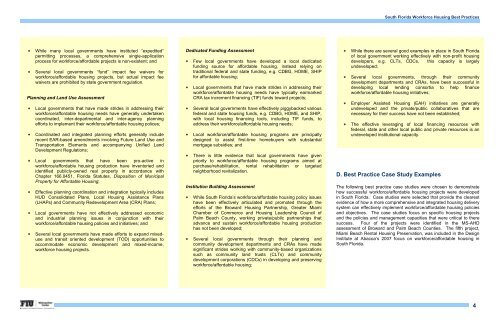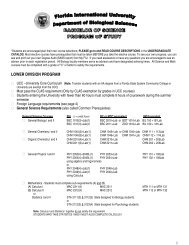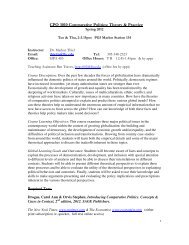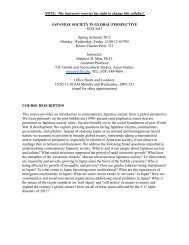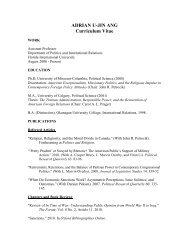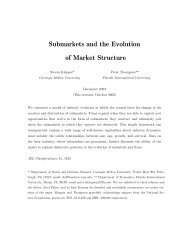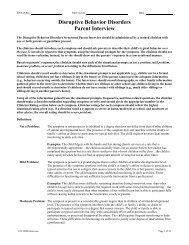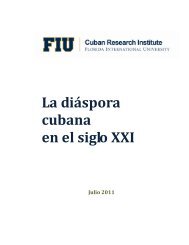South Florida Workforce Housing Best Practices
South Florida Workforce Housing Best Practices
South Florida Workforce Housing Best Practices
You also want an ePaper? Increase the reach of your titles
YUMPU automatically turns print PDFs into web optimized ePapers that Google loves.
∗ While many local governments have instituted “expedited”<br />
permitting processes, a comprehensive single-application<br />
process for workforce/affordable projects is non-existent; and<br />
∗ Several local governments “fund” impact fee waivers for<br />
workforce/affordable housing projects, but actual impact fee<br />
waivers are prohibited by state government regulation.<br />
Planning and Land Use Assessment<br />
∗ Local governments that have made strides in addressing their<br />
workforce/affordable housing needs have generally undertaken<br />
coordinated, inter-departmental and inter-agency planning<br />
efforts to implement their workforce/affordable housing polices;<br />
∗ Coordinated and integrated planning efforts generally include<br />
recent EAR-based amendments involving Future Land Use and<br />
Transportation Elements and accompanying Unified Land<br />
Development Regulations;<br />
∗ Local governments that have been pro-active in<br />
workforce/affordable housing production have inventoried and<br />
identified publicly-owned real property in accordance with<br />
Chapter 166.0451, <strong>Florida</strong> Statutes, Disposition of Municipal<br />
Property for Affordable <strong>Housing</strong>;<br />
∗ Effective planning coordination and integration typically includes<br />
HUD Consolidated Plans, Local <strong>Housing</strong> Assistance Plans<br />
(LHAPs) and Community Redevelopment Area (CRA) Plans;<br />
∗ Local governments have not effectively addressed economic<br />
and industrial planning issues in conjunction with their<br />
workforce/affordable housing policies and initiatives; and<br />
∗ Several local governments have made efforts to expand mixeduse<br />
and transit oriented development (TOD) opportunities to<br />
accommodate economic development and mixed-income,<br />
workforce housing projects.<br />
Dedicated Funding Assessment<br />
∗ Few local governments have developed a local dedicated<br />
funding source for affordable housing, instead relying on<br />
traditional federal and state funding, e.g. CDBG, HOME, SHIP<br />
for affordable housing;<br />
∗ Local governments that have made strides in addressing their<br />
workforce/affordable housing needs have typically earmarked<br />
CRA tax increment financing (TIF) funds toward projects;<br />
∗ Several local governments have effectively piggybacked various<br />
federal and state housing funds, e.g. CDBG, HOME, and SHIP,<br />
with local housing financing tools, including TIF funds, to<br />
address their workforce/affordable housing needs;<br />
∗ Local workforce/affordable housing programs are principally<br />
designed to assist first-time homebuyers with substantial<br />
mortgage subsidies; and<br />
∗ There is little evidence that local governments have given<br />
priority to workforce/affordable housing programs aimed at<br />
purchase/rehabilitation, rental rehabilitation or targeted<br />
neighborhood revitalization.<br />
Institution Building Assessment<br />
∗ While <strong>South</strong> <strong>Florida</strong>’s workforce/affordable housing policy issues<br />
have been effectively articulated and promoted through the<br />
efforts of the Broward <strong>Housing</strong> Partnership, Greater Miami<br />
Chamber of Commerce and <strong>Housing</strong> Leadership Council of<br />
Palm Beach County, working private/public partnerships that<br />
advance and sustain workforce/affordable housing production<br />
has not been developed;<br />
∗ Several local governments through their planning and<br />
community development departments and CRAs have made<br />
significant strides working with community-based organizations<br />
such as community land trusts (CLTs) and community<br />
development corporations (CDCs) in developing and preserving<br />
workforce/affordable housing;<br />
<strong>South</strong> <strong>Florida</strong> <strong>Workforce</strong> <strong>Housing</strong> <strong>Best</strong> <strong>Practices</strong><br />
∗ While there are several good examples in place in <strong>South</strong> <strong>Florida</strong><br />
of local government working effectively with non-profit housing<br />
developers, e.g. CLTs, CDCs, this capacity is largely<br />
undeveloped;<br />
∗ Several local governments, through their community<br />
development departments and CRAs, have been successful in<br />
developing local lending consortia to help finance<br />
workforce/affordable housing initiatives;<br />
∗ Employer Assisted <strong>Housing</strong> (EAH) initiatives are generally<br />
undeveloped and the private/public collaboratives that are<br />
necessary for their success have not been established;<br />
∗ The effective leveraging of local financing resources with<br />
federal, state and other local public and private resources is an<br />
undeveloped institutional capacity.<br />
D. <strong>Best</strong> Practice Case Study Examples<br />
The following best practice case studies were chosen to demonstrate<br />
how successful workforce/affordable housing projects were developed<br />
in <strong>South</strong> <strong>Florida</strong>. Case studies were selected that provide the clearest<br />
evidence of how a more comprehensive and integrated housing delivery<br />
system can effectively implement workforce/affordable housing policies<br />
and objectives. The case studies focus on specific housing projects<br />
and the policies and management capacities that were critical to there<br />
success. Four of the projects were identified in the MS-AHD<br />
assessment of Broward and Palm Beach Counties. The fifth project,<br />
Miami Beach Rental <strong>Housing</strong> Preservation, was included in the Design<br />
Institute at Abacoa’s 2007 focus on workforce/affordable housing in<br />
<strong>South</strong> <strong>Florida</strong>.<br />
4


